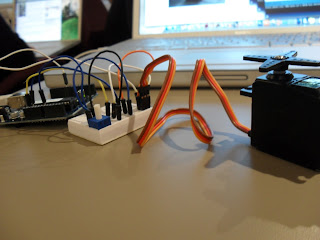Just got back from day 2 of Smart Surfaces (it's a weekly, all day Friday course). It was a fun day, quite interesting and all new for me. We worked with Arduino over the course of the week on our own and then today learned some slightly more advanced things.
We started with LDR cells (photoresistor cells).
LDR lessons here.

The arduino and breadboard for the LDR circuit.
We then moved on to H-bridges. An H-bridge is an electronic circuit which enables a voltage to be applied across a load in either direction. These circuits allow DC motors to run both forwards and backwards. H-bridges are generally used to reverse the polarity of a motor, but can also be used to 'brake' the motor, where the motor comes to a sudden stop.
HBridge lessons here.

The h-bridge set up.
Finally we moved onto servo motors.
Servo lessons here.

The servo motor set up.
All this learning was set up towards our exercise for the day, making photoresistor cells follow a light source. Our team used the photo cells, and the servo motors to accomplish this goal. We didn't really use the h-bridge because we only had an hour to accomplish the whole thing. I don't have any picture even because we were working so diligently. Our homework this week though is to get back together and perfect our designs so I'll have pictures once were done with that. This class is so interesting and actually quite fun!
Last week I had commented on the different knowledge basis that the different students had and today it was apparent again. One of the engineering students (whose name now escapes me, sorry!), knew what to do with the coding side and really was the director for our team today on the electronic side of things. I helped to put together some circuits and build the base that our servo motors moved on and the housing for our photo cells to thus follow light from. It was fun!
I'll have more later, once we meet again.
Just a point, for anyone remotely interested in this or any interdisciplinary work on design, engineering, check out the Smart Surfaces website. It's so much more than a simple course site.
Thanks for reading!













